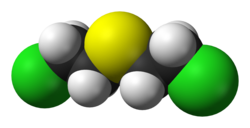 | |
 | |
 | |
| Names | |
|---|---|
| Preferred IUPAC name 1-Chloro-2-[(2-chloroethyl)sulfanyl]ethane | |
| Other names Bis(2-chloroethyl) sulfide HD Iprit Schwefel-LOST Lost Sulfur mustard Senfgas Yellow cross liquid Yperite Distilled mustard Mustard T- mixture 1,1'-thiobis[2-chloroethane] Dichlorodiethyl sulfide | |
| Identifiers | |
3D model (JSmol) | |
| 1733595 | |
| ChEBI | |
| ChEMBL | |
| ChemSpider | |
| EC Number |
|
| 324535 | |
| KEGG | |
PubChem CID | |
| UNII | |
| |
| |
| Properties | |
| C4H8Cl2S | |
| Molar mass | 159.07 g·mol−1 |
| Appearance | Colorless if pure. Normally ranges from pale yellow to dark brown. Slight garlic or horseradish type odor. [1] |
| Density | 1.27 g/mL, liquid |
| Melting point | 14.4 °C (57.9 °F; 287.5 K) |
| Boiling point | 217 °C (423 °F; 490 K) begins to decompose at 217 °C (423 °F) and boils at 218 °C (424 °F) |
| 7.6 mg/L at 20°C [2] | |
| Solubility | Alcohols, ethers, hydrocarbons, lipids, THF |
| Hazards | |
| Occupational safety and health (OHS/OSH): | |
Main hazards | Flammable, toxic, vesicant, carcinogenic, mutagenic |
| GHS labelling: [3] | |
  | |
| Danger | |
| H300, H310, H315, H319, H330, H335 | |
| P260, P261, P262, P264, P270, P271, P280, P284, P301+P310, P302+P350, P302+P352, P304+P340, P305+P351+P338, P310, P312, P320, P321, P322, P330, P332+P313, P337+P313, P361, P362, P363, P403+P233, P405, P501 | |
| NFPA 704 (fire diamond) | |
| Flash point | 105 °C (221 °F; 378 K) |
| Safety data sheet (SDS) | External MSDS |
| Related compounds | |
Related compounds | Nitrogen mustard, Bis(chloroethyl) ether, Chloromethyl methyl sulfide |
Except where otherwise noted, data are given for materials in their standard state (at 25 °C [77 °F], 100 kPa). | |
Bis(2-chloroethyl)sulfide is the organosulfur compound with the formula (ClCH2CH2)2S. It is a prominent member of a family of cytotoxic and blister agents known as mustard agents. Sometimes referred to as mustard gas , the term is technically incorrect: bis(2-chloroethyl)sulfide is a liquid at room temperature. In warfare it was dispersed in the form of a fine mist of liquid droplets. [4] [5]
